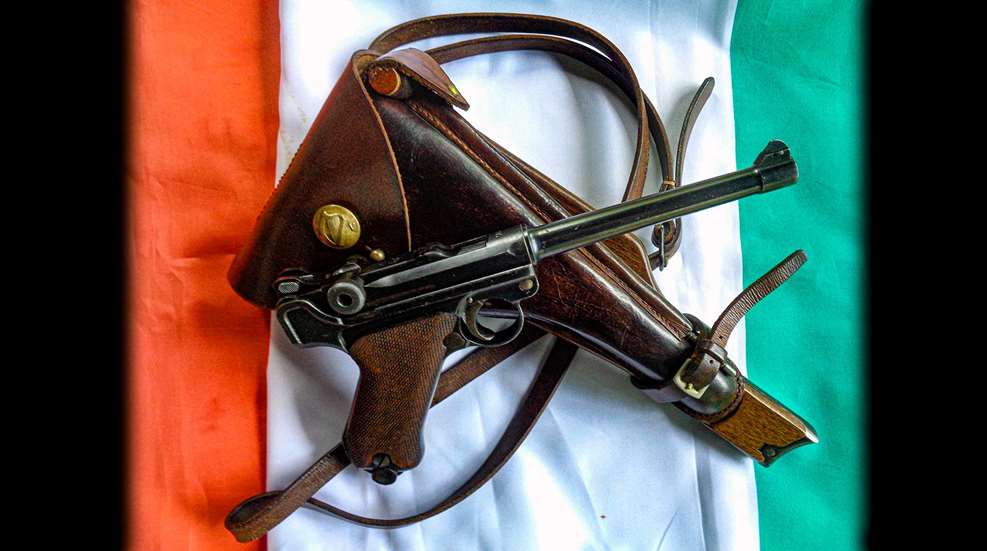
In the 1970s, Maj. Richard J. Keogh, a retired U.S. Army ordnance officer, was visiting his sister in Ireland, where she had returned some years previously, having been raised in Massachusetts. The Keogh family had emigrated to New England from Ireland in the early 20th century, and it contained a number of relatives who were notable personalities during the “Troubles” of 1916-1923. Richard (“Dick”) had joined the U.S. Army in the post-World War II period and had served with distinction in Vietnam before retiring in Hawaii. While taking care of his sibling in Dublin during her recuperation from surgery, he visited the museum at Kilmainham Gaol, and, having time on his hands, offered his expertise to the museum’s staff in re-cataloging their arms collection.
During his work in Kilmainham’s collection (about which he later wrote an article for Arms Gazette), he found very few books or articles that specifically detailed the use of various firearms in the “Irish Revolution” of 1913-1923, although there was information about their use in other published histories. Realizing there was a need to be filled, Dick used those accounts and published the following article about Irish Lugers in March 1979 for Arms Gazette:
The Irish War of Independence stretched from 1916 to 1921. This period was followed by the Irish Civil War, which raged from 1922 to 1923. The Luger pistol, in several variations, played a key role in these events. One would expect that most of the handguns used in such guerilla wars would be a British origin. Capturing or stealing from the occupying power is the usual source of supply for guerillas. Certainly, the Nationalist forces did use many British weapons. They also used a surprising number of Luger pistols. No attention has been paid to this usage in any of the many books on the Luger.
The initial rising by the Nationalist forces was made in Dublin in late April 1916. The British suppressed this “Easter Rising,” and most of the leaders were executed. There is no indication in any of the available literature that Lugers were used in 1916. However, the Nationalist movement re-organized and after World War I ended, and the Irish War of Independence began again. This time, there were no poets and scholars among their leaders, just very hard conspirators. There were also many Irish patriots who had served in World War I and were fully familiar with good pistols. A supply system was organized the smuggle arms in from Europe and the Luger came to the forefront.
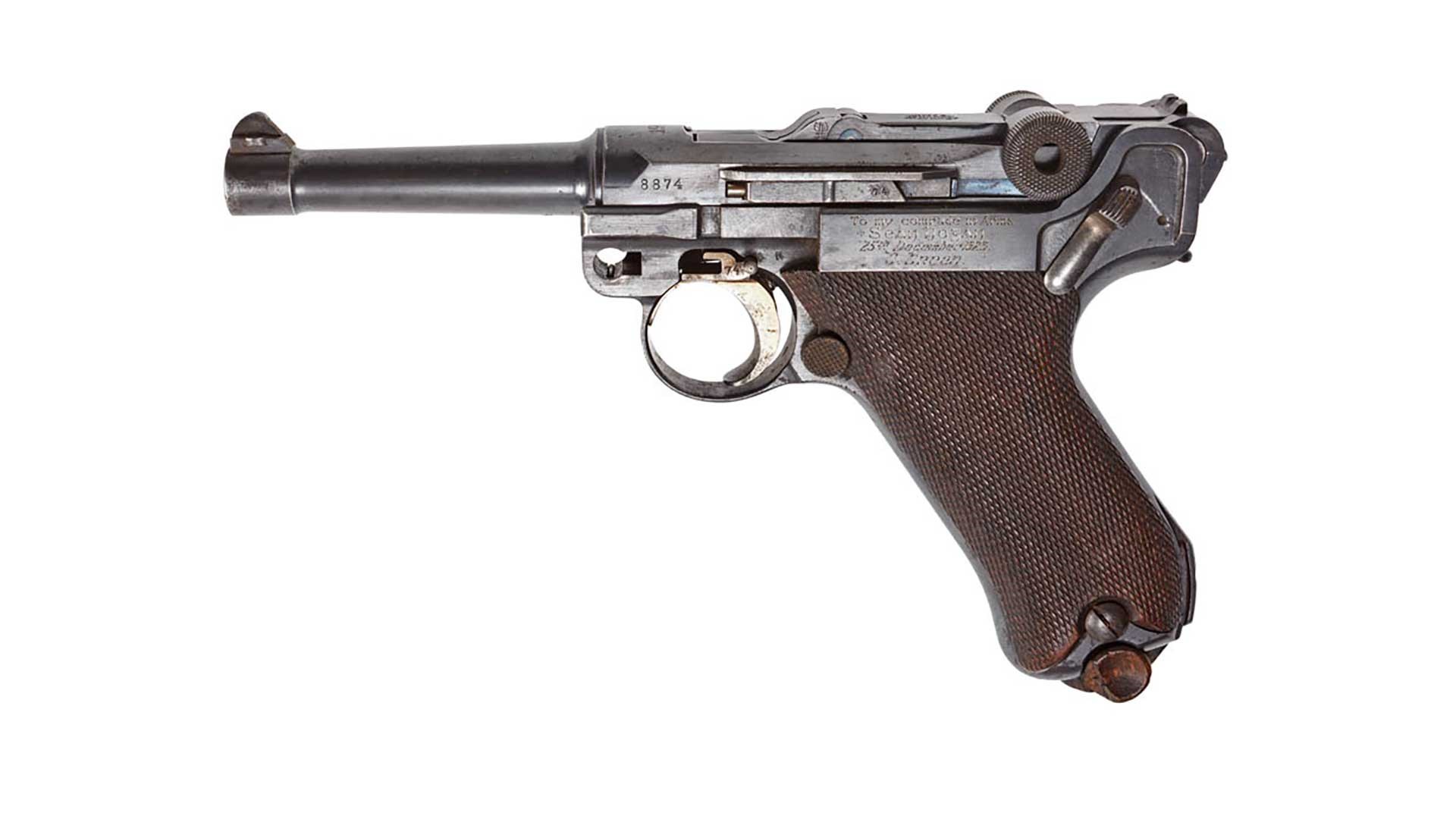 Dan Breen, one of the most noted fighters for Irish freedom, carried this P '08 Luger in several storied actions, and gave it to his best friend, Sean Hogan, at the end of the War of Independence. After his death, Hogan's family donated the pistol to the National Museum of Ireland, where it is now on exhibit in the "Soldiers and Chiefs" gallery at the former Collins Barracks. Photo courtesy of the National Museum of Ireland.
Dan Breen, one of the most noted fighters for Irish freedom, carried this P '08 Luger in several storied actions, and gave it to his best friend, Sean Hogan, at the end of the War of Independence. After his death, Hogan's family donated the pistol to the National Museum of Ireland, where it is now on exhibit in the "Soldiers and Chiefs" gallery at the former Collins Barracks. Photo courtesy of the National Museum of Ireland.
The first action in the renewed War of Independence was fought at Soloheadbeg in Tipperary. The leader in this fight was Dan Breen, who became one of the legendary figures in the war. Breen used a stolen rifle in his first fight, but he soon was transferred from rural Tipperary into Dublin, where he was issued a Luger. Breen carried and used a Luger and a series of gun battles in the war from 1919 to 1921. He became a member of the elite Active Service Unit of the Dublin Brigade. These select full-time guerillas waged a continual battle against the British soldiers, police, intelligence agents, political detectives and informers in the streets and alleys of Dublin. On one occasion when they had Breen surrounded, he and a comrade killed 13 of them and made their escape.
On Christmas, 1923, Breen gave his Luger to an old comrade, Sean Hogan, who was with him in that first battle at Soloheadbeg in 1919. Hogan kept the pistol all his life, despite the rigid Irish firearms laws. After his death in 1968, his family gave the Breen-Hogan Luger to the Irish National Museum. This Luger is now on display. The Breen-Hogan Luger is a 1914 military model, dated 1915, and it was made by DWM. The serial number is 8874 and all numbers match except for the magazines. The side of the frame is engraved in Celtic-type lettering, “To my comrade in arms, Sean Hogan, 25th December 1923, D. Breen.” The pistol is accompanied with a standard German Army-issue holster of World War I vintage.
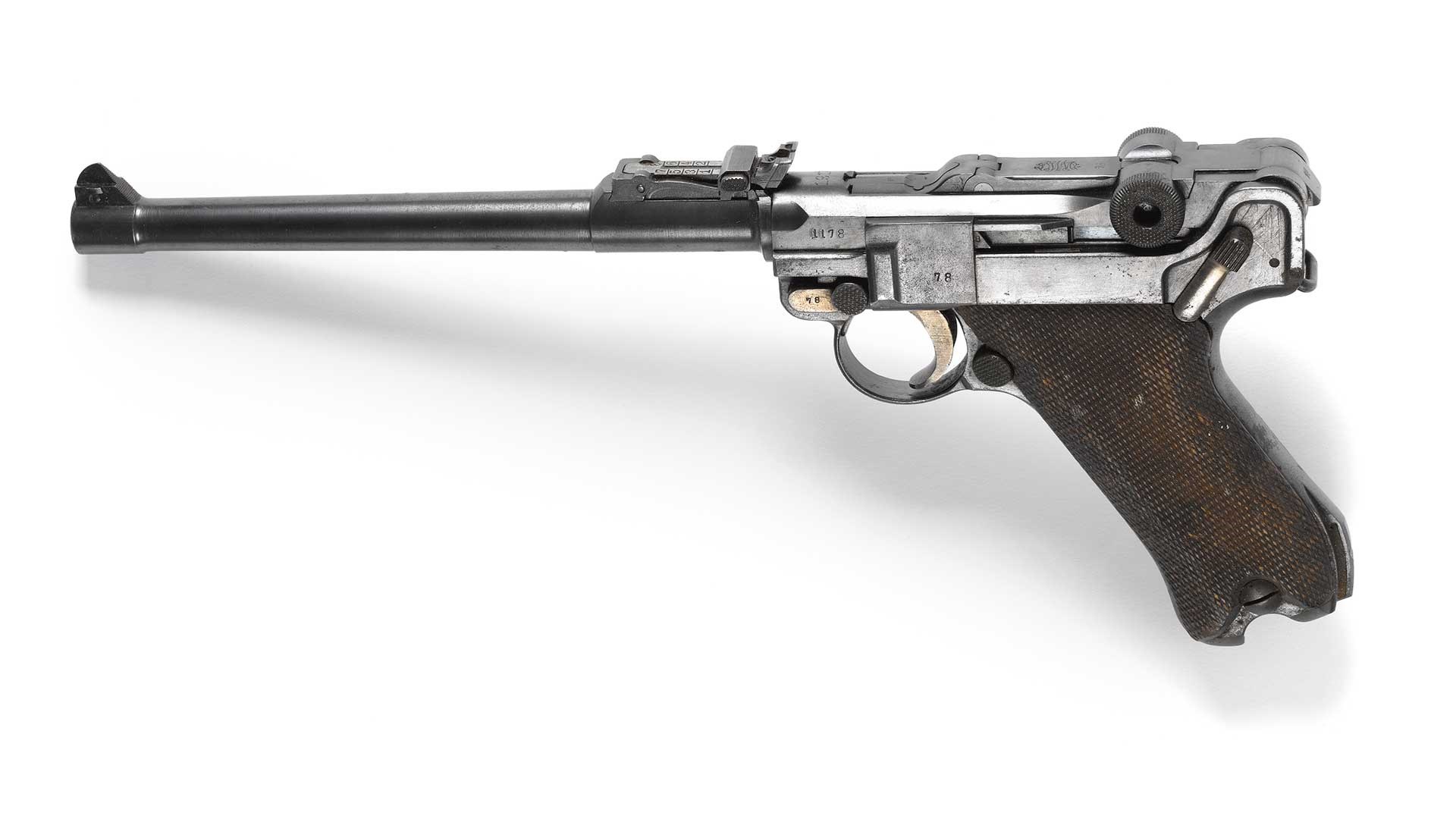 Sean Treacy was firing this Artillery model Luger when he was killed in a shootout during the Irish War of Independence. Thankfully, in the 1940s, it was recognized by the then-curator of the National Museum of Ireland as a historically significant artifact and put on display—where it remains today. Photo courtesy of the National Museum of Ireland.
Sean Treacy was firing this Artillery model Luger when he was killed in a shootout during the Irish War of Independence. Thankfully, in the 1940s, it was recognized by the then-curator of the National Museum of Ireland as a historically significant artifact and put on display—where it remains today. Photo courtesy of the National Museum of Ireland.
Not all of the Nationalist fighters had the success with their Lugers that Breen had with his. Sean Treacy was with Breen in the Soloheadbeg battle, and they were together in the Active Service Unit. They were in the night gunfight where 13 British were killed. Treacy carried an artillery model Luger. This pistol, with its eight-inch barrel, must have been a problem to carry concealed on the streets of Dublin. The Treacy Luger was made by DWM in 1917, and it carries serial number 1178b. This number, or the abbreviation 78, is on all of its parts. There is no magazine in the pistol. Treacy was ambushed and killed on Talbot Street, Dublin, by British task force on October 14, 1920. The artillery Luger was taken off his body, put into storage as a captured weapon, and eventually turned over to the Irish Free State Army in 1922. It remained in storage until the Irish Army disposed of such captured stocks in 1948 (*Note—More to come on this.) At that time, Professor Hayes McCoy secured the Treacy Luger for display in the Irish National Museum.
Another unfortunate Nationalist guerilla that used a Luger was the teenaged Kevin Barry. He was a student and part-time soldier in the Dublin Brigade. He participated in an ambush of a British army ration detail on September 20, 1920. Barry and his comrades were armed with various pistols; records indicate Barry had a Luger. The British troops were armed with rifles. When the shooting stopped, one soldier was dead, two were dying of wounds, and another one had been shot in the foot. Barry was captured by the relief of column of troops that arrived from a nearby barracks. The contemporary accounts say that Barry was armed with a “.38 Parabellum” which jammed on the second and fifth shot. Barry was trying to clear the second stoppage when captured. Now, the Luger is a reliable military pistol when supplied with proper ammunition. It may well be that Kevin Barry was trying to use some kind of .38 ammunition, instead of the proper 9mm cartridge.
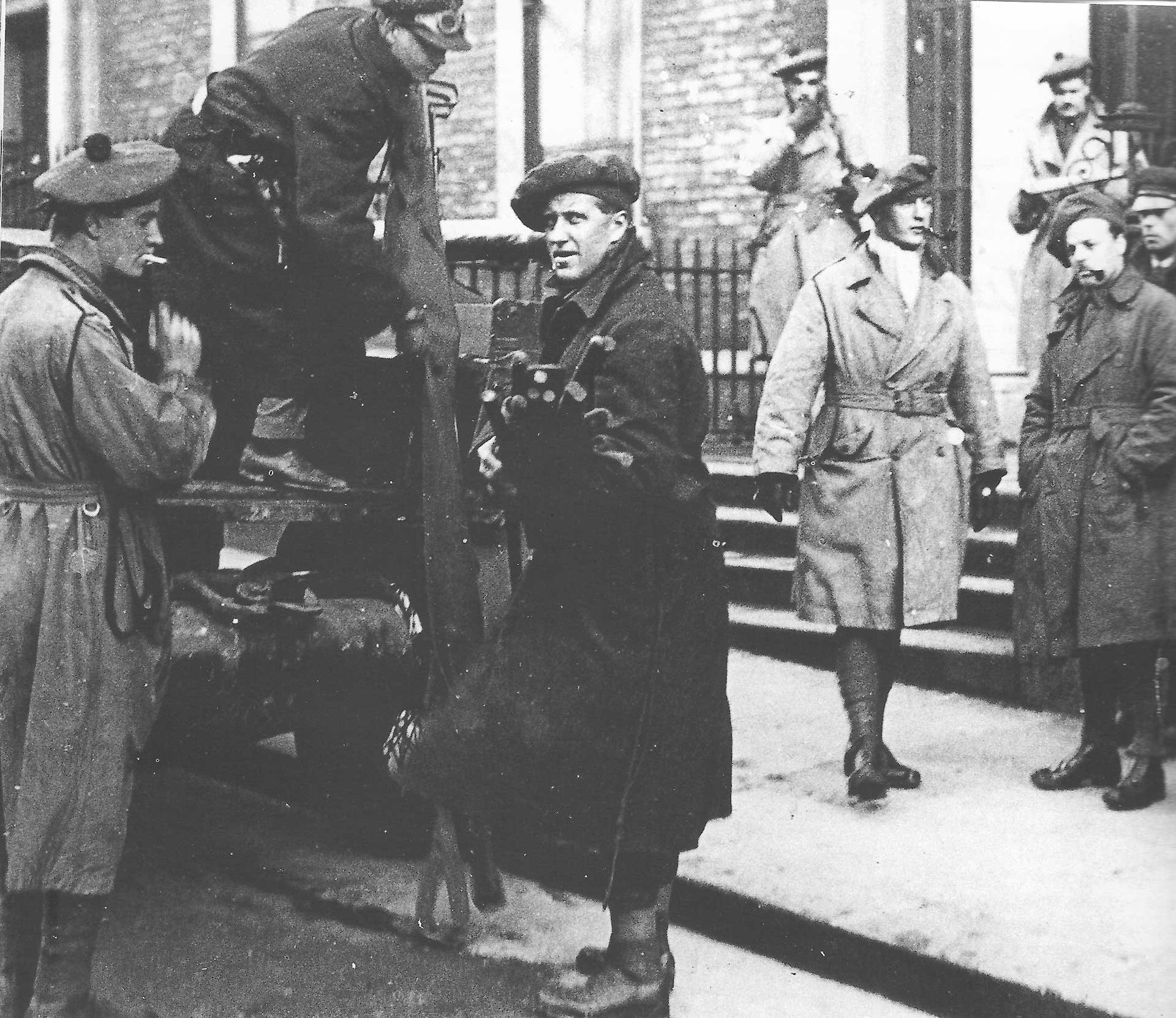 The “Forces of the Crown” constantly patrolled the streets of Dublin in 1920 and 1921, and during such a patrol, Sean Treacy was killed in a gun battle with British troops, police and secret agents. Kevin Barry, along with his Luger, was captured after an IRA raid on a British supply mission.
The “Forces of the Crown” constantly patrolled the streets of Dublin in 1920 and 1921, and during such a patrol, Sean Treacy was killed in a gun battle with British troops, police and secret agents. Kevin Barry, along with his Luger, was captured after an IRA raid on a British supply mission.
Barry was tried by British court martial on October 20, 1920 and hanged on November 1, 1920. The whereabouts of the Barry Luger is not known. It must have been seized by the British, and held in the captured stocks. Considering the fame of Kevin Barry, it is a shame that his Luger has been lost.
Ernie O'Malley, who afterwards wrote one of the best books on the War of Independence, also used a Luger when he raided the 17th Lancers’ barracks in Mallow. When O'Malley operated in open country, he carried a Winchester rifle and a model 1896 Mauser with a wooden shoulder stock. When he went to Dublin, or any large town, he carried a Luger and a Smith and Wesson .45 revolver. Either of these pistols would be enough armament for the average man; wearing both of them was truly formidable. He describes his Luger as a “long barreled Parabellum”, so it must have been an artillery model. (*Note—It also could have been a navy model.)
Many lesser-known Irish soldiers also carried Lugers in the War of Independence. The literature of the period gives us only a small part of the picture, because the writers usually refer to any handgun as a revolver. Recent (1978) conversations with a few surviving veterans indicate that the Luger, which they uniformly call a “Parabellum,” was quite common in the War of Independence. Many were smuggled in from Germany, where they were abundant, after the end of World War I. Others were bought in England from ex-servicemen who had carried a Luger home from France as a souvenir.
The War of Independence ended in July 1921 when the British signed a truce with the Irish Republican Army. The Luger had played a vital part in the first successful revolt against the British Empire since 1781, when General George Washington won American independence. Ireland endured a bloody and brutal civil war from mid-1922 to late 1923. The use of Lugers in the Irish Civil War cannot be as fully documented as can be done for the War of Independence.
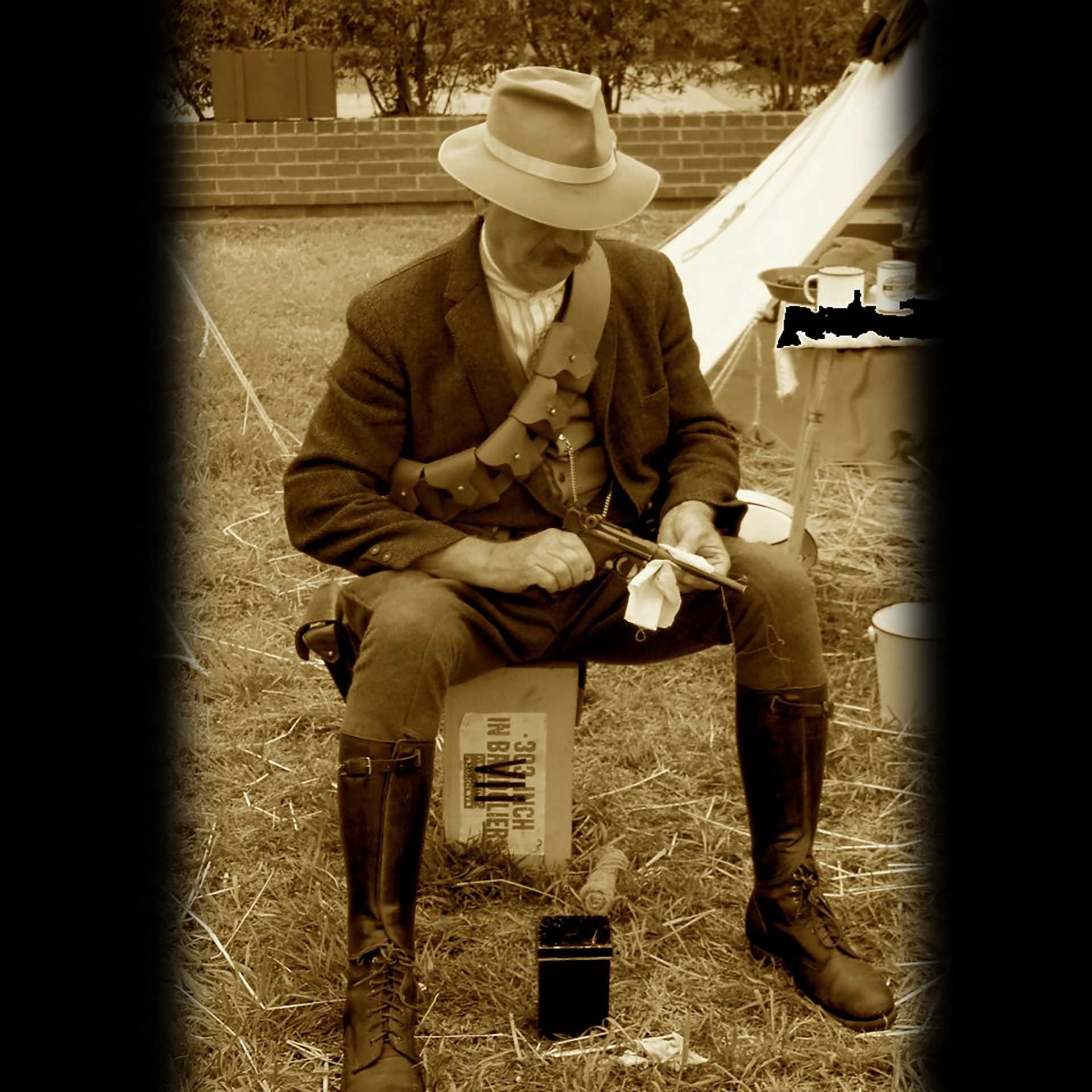 A member of the West Cork Flying Column, IRA, cleans his M1906 Navy Luger in camp during a living history presentation at Jamestown Festival Park in Virginia. Author photo.
A member of the West Cork Flying Column, IRA, cleans his M1906 Navy Luger in camp during a living history presentation at Jamestown Festival Park in Virginia. Author photo.
One exception is Ernie O'Malley. He was on the Republican, or insurgent, side of the Civil War. He carried and used his “long barreled” Luger during the occupation of the Four Courts building in Dublin in June 1922. This occupation and other acts of defiance towards the Free State government touched off the Civil War. The National Army borrowed artillery from the departing British army, shelled the Four Courts and forced the Republicans to surrender. O’Malley stripped his Luger and threw the toggle assembly into the burning ruins of the Four Courts. As the final gesture of defiance at the surrender formation, he threw the barrel and the frame into the Liffey River. Perhaps all the Republicans did the same thing before they surrendered during the Civil War, which might account for so few Lugers surviving from that conflict. After the end of the Civil War most of the weapons in Ireland were rounded up, and the Firearms Act of 1924 drastically restricted ownership of weapons.
From 1932 to 1938, Ireland and Britain were locked in an “economic war.” Each forbade imports from the other. The situation posed quite a problem for the Irish army that was armed and equipped with British material turned over at the 1921 Truce. To solve the problem, the Irish army procured some types of equipment in Germany. For a time, Irish units wore the German “coal-scuttle” helmets, for instance. (*Note: These helmets, made by Vickers-Armstrong in England on surrendered German machinery—part of the reparations agreement in the Versailles Treaty—were acquired in 1932, before the import ban went into effect.) Reports persist that the Irish army obtained several hundred artillery and naval model Lugers during this period. At least one prominent collector and other prominent arms dealers claim that these Lugers are still in storage in an army Irish army depot. The Irish Defense Forces Ordnance Corps has not responded to a written inquiry as to whether or not these Lugers still exist. (*Note—More to come on this!)
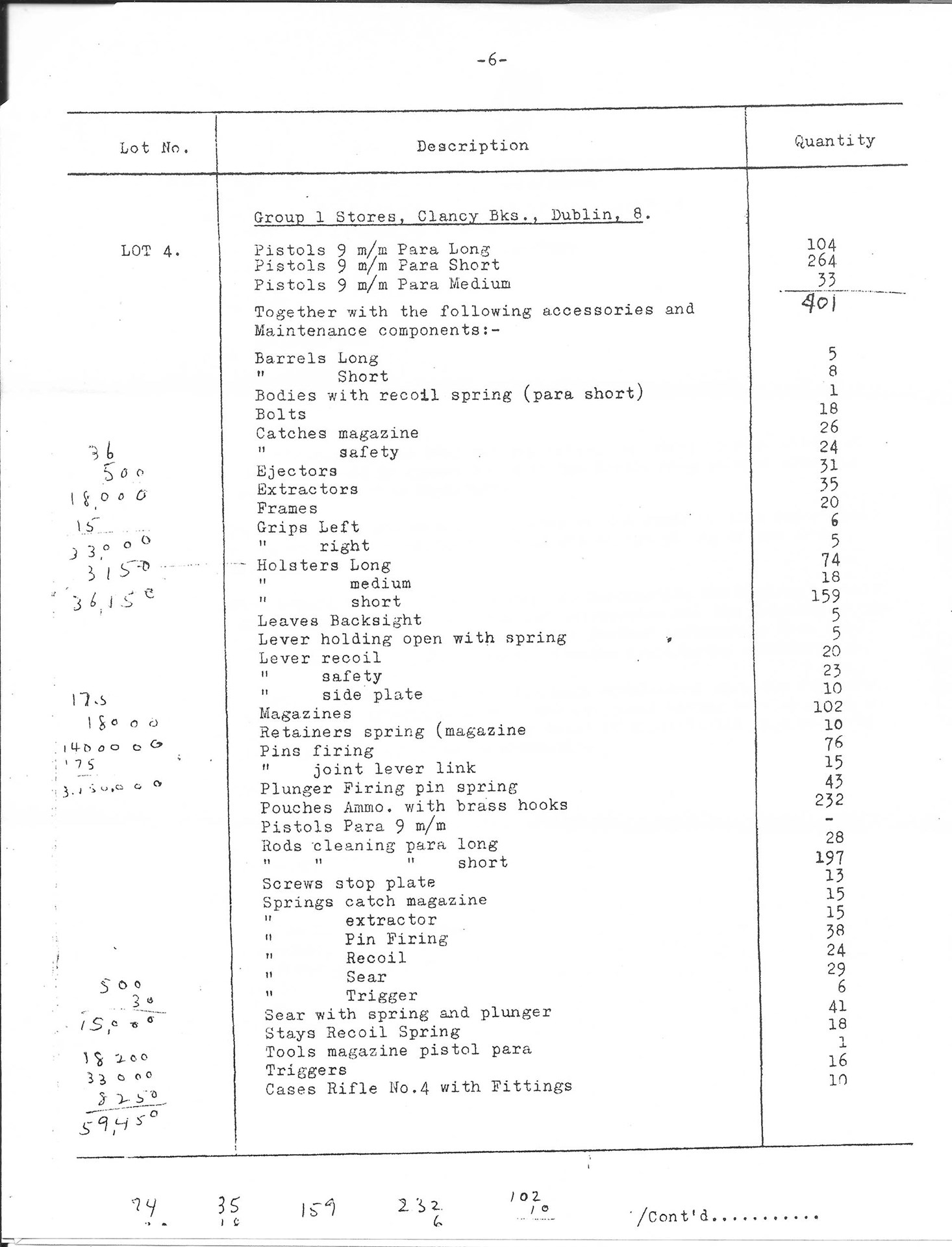 As William B. Edwards noted in his letter (seen later in this article), the Irish Defense Forces had offered the Lugers and other surplus arms to him in 1969, (as seen here) but he could not purchase them then because of the restrictions of the 1968 Gun Control Act. These restrictions were lifted in 1985, thus enabling the 1990 auction. Note the offered holsters. Photo courtesy of Vince Rausch.
As William B. Edwards noted in his letter (seen later in this article), the Irish Defense Forces had offered the Lugers and other surplus arms to him in 1969, (as seen here) but he could not purchase them then because of the restrictions of the 1968 Gun Control Act. These restrictions were lifted in 1985, thus enabling the 1990 auction. Note the offered holsters. Photo courtesy of Vince Rausch.
But the Irish fascination with a Luger did not end in the 1930s; it continues into our own times. In May 1970, the Irish police arrested four men and charged them with conspiring to smuggle 500 Luger pistols into the Republic of Ireland. These four included a captain in military intelligence and a cabinet minister. The pistols were supposedly to be distributed in the British occupied area of Northern Ireland, if the sectarian violence worsened. The four accused were tried in September and October 1970. Testimony at the trial was to the effect that at least two of them inspected the 500 unused Luger pistols in Austria in January 1970. Throughout the trial, the pistols were referred to as “Lugers.” The problem with this, from my point of view, is that the most recent, and best, book on Luger pistols states that the Mauser plant did not start making new Lugers until November 1970. John Walter did massive and painstaking researcher for his book, Luger, published in 1977. It is inconceivable that he could be wrong on a point as easy to verify as that of the date on which Mauser resumed production of the Luger.
So perhaps, the Irish authorities and writers were wrong. Perhaps the 500 unused pistols were merely in a Luger caliber, but of another make. It is possible, of course, that these were reconditioned World War II Lugers being passed off as unused pistols. However, American arms importers had scoured all of Europe in the fifties and sixties, and it is hard to believe that a cache of 500 Lugers would have eluded them. All we have to go on is the testimony given in Bridewell Court, where the pistols were described as Lugers. Incidentally the jury acquitted all four defendants.
The story of the Luger in Ireland is much like that land itself, obscured by mist and myth. We do know that the Lugers used in the War of Independence were all battlefield pick-ups from World War I. (*Note: Not necessarily so—see paragraph 10, above.) There was no “IRA Contract Luger.” Beware the charming rogue who tries to sell you a Luger with shamrock and harp proofs, “Faith” on the safety recess, and “Begorrah” on the extractor. More seriously, the Breen-Hogan Luger with its Celtic lettered inscription would be easy for the unscrupulous to duplicate. Any offer of an Irish revolutionary Luger should be accompanied by unimpeachable documentation that traces the pistol back to its origin.
In some countries, where a “contract” Luger was the official sidearm, these pistols saw less combat than did the second- and third-hand Lugers of the Irish Republican Army. It is with good reason that one book about the War of Independence mentions “The fearsome Painters and Parabellums of the squad.” You can add Ireland to the roster of nations in which the Luger pistol served with distinction”.
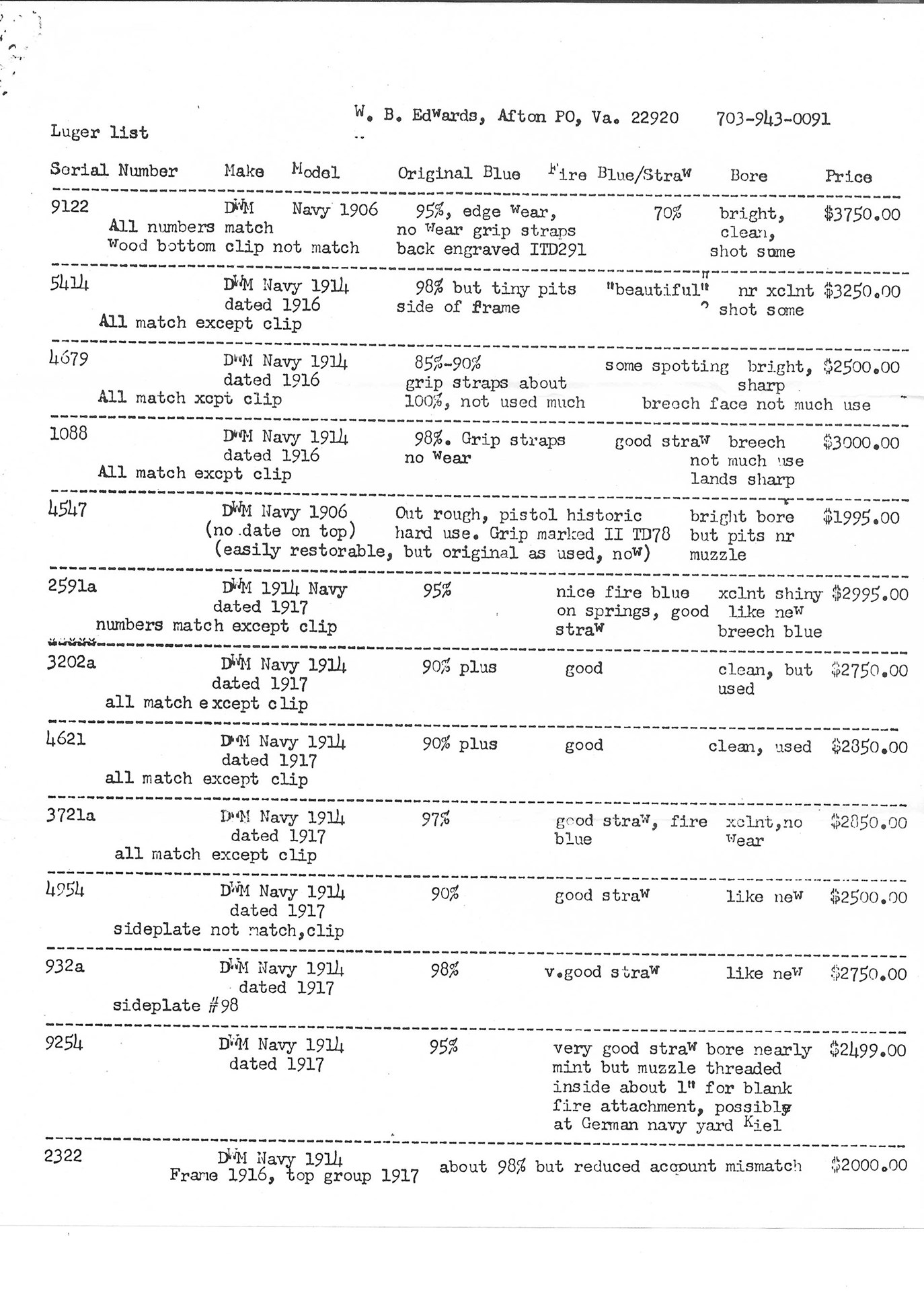
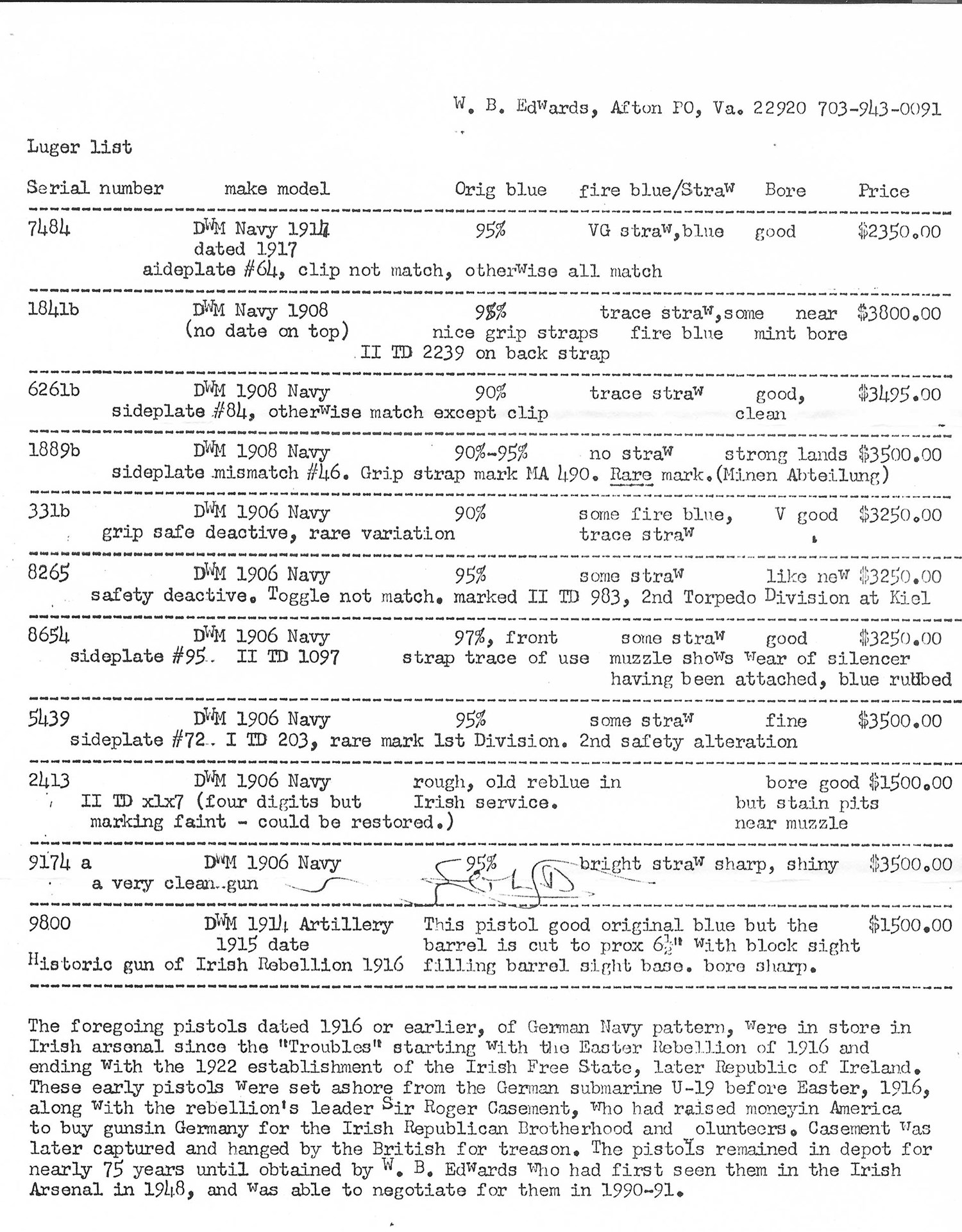 Edwards typed this two-page listing of the guns that he had purchased from the Irish Defense Forces in 1990. Although Luger collectors have been discussing this list on the Internet for at least the past 10 years, there is far more information about Irish Lugers now available to researchers from other sources. Author photos.
Edwards typed this two-page listing of the guns that he had purchased from the Irish Defense Forces in 1990. Although Luger collectors have been discussing this list on the Internet for at least the past 10 years, there is far more information about Irish Lugers now available to researchers from other sources. Author photos.
A dozen years after this article was published, a trio of arms enthusiasts from Virginia bid on Lugers, Mauser C96 “Broomhandle” pistols, and other guns in an auction being held by the Irish Defense Forces in Dublin, but they were only successful in their bid on the Navy Lugers. Anticipating a move from the Peadar Clancy Barracks (formerly the British Army’s pre-1922 Islandbridge Barracks) in Dublin to the Irish Army’s Curragh Camp in Kildare, the Irish Defense Forces’ Ordnance Corps had to dispose of obsolete surplus arms—some of which had been stored in the barracks for years and years—and they officially set up a formal auction.
Noted author and firearms authority, William B. Edwards, led the trio and had seen the Lugers, among thousands of other arms, during a visit to the barracks in 1948. Later, in the late 1950s, he accompanied the legendary Sam Cummings (the founder of International Armaments Corporations—“Interarms” or “Interarmco”) on another visit to the Clancy Barracks. These were the visits that prompted Dick Keogh’s remarks in his article about the Lugers being in an Irish depot. Cummings subsequently purchased about 28,000 Short, Magazine Lee Enfields (SMLEs), thousands of Webley revolvers, assorted “old Mausers” and other arms, and he then sold them in the United States during the 1960s and 1970s, along with a veritable shipload of Irish (formerly British) artillery and machine guns (see “Ivy Patch Gun” and “Irish Light Lewis Machine Guns in the United States”). However, the Lugers and the Mauser “Broomhandle” pistols were not included in that 1959 deal and were now up for auction in 1990.
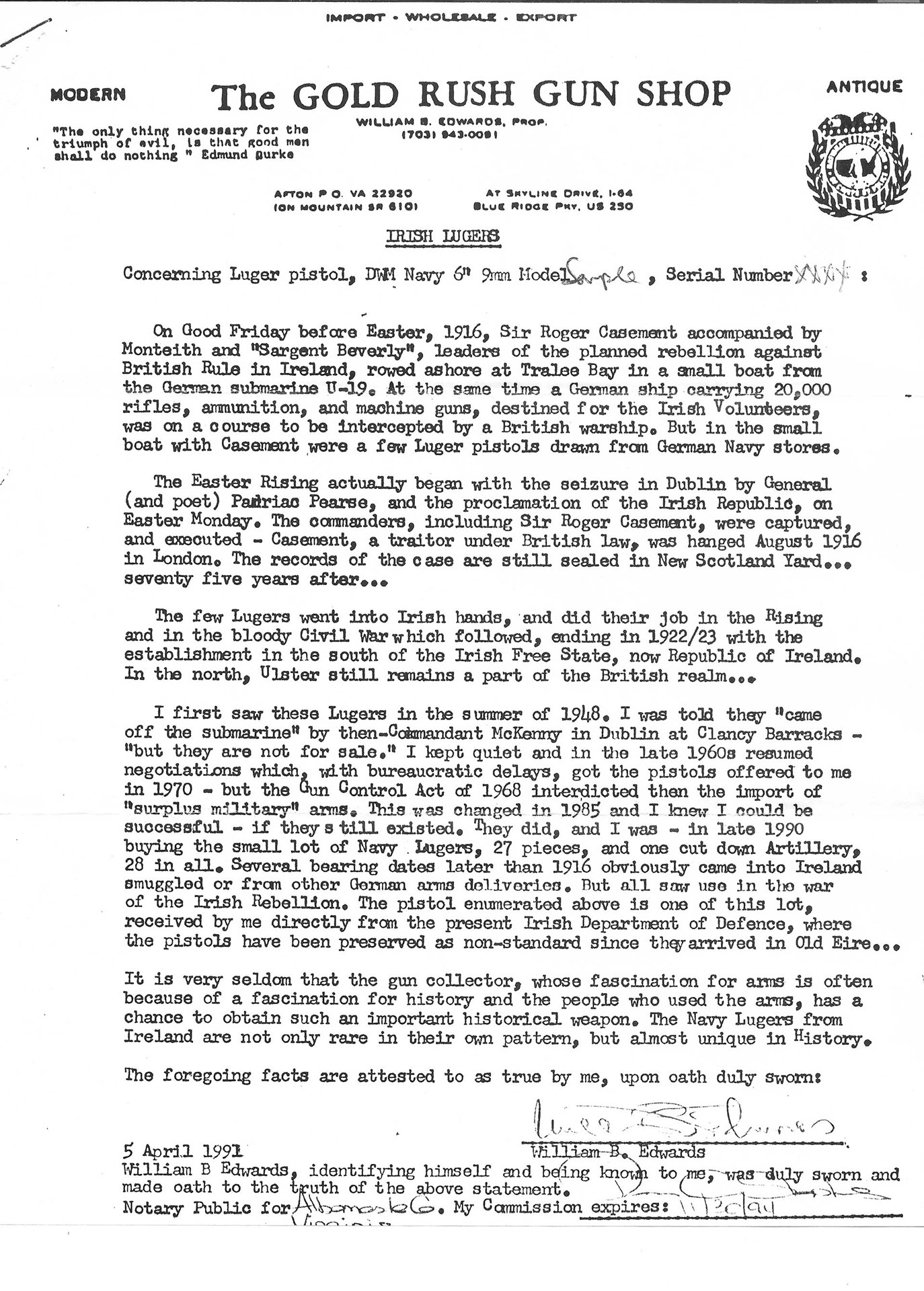 Although this letter does not detail Edwards’ engraving “1916” on the extractor of each of the Navy Lugers he and his colleagues acquired from the Irish Defense Forces in 1990, he noted that he had in a letter to one of the authors in the mid-1990s. When pressed for details about the “Casement Connection” after a presentation on Irish Nationalist guns at NRA HQ by one of the authors some 15 or so years ago, Edwards could not substantiate, or further illuminate, his tale of the Navy Lugers’ origins. However, it must be remembered that Irish accounts of the period often confuse firearms makers and types (like “Lugers” and “Mausers”), so Edwards’ “Casement Connection” cannot be dismissed altogether. Author photo.
Although this letter does not detail Edwards’ engraving “1916” on the extractor of each of the Navy Lugers he and his colleagues acquired from the Irish Defense Forces in 1990, he noted that he had in a letter to one of the authors in the mid-1990s. When pressed for details about the “Casement Connection” after a presentation on Irish Nationalist guns at NRA HQ by one of the authors some 15 or so years ago, Edwards could not substantiate, or further illuminate, his tale of the Navy Lugers’ origins. However, it must be remembered that Irish accounts of the period often confuse firearms makers and types (like “Lugers” and “Mausers”), so Edwards’ “Casement Connection” cannot be dismissed altogether. Author photo.
Included in the letters that Edwards sent out advertising the guns that the trio now had for sale is an unverified (and perhaps fanciful) story of how the Lugers came to Ireland. Although Edwards focuses on at least some of his Navy Lugers being involved with Sir Roger Casement’s futile landing on the shores of Banna Strand on the eve of the 1916 Easter Rising, all of the available documentation states that the pistols captured from Casement and his two companions were “Mausers”, with no mention of “Lugers” or “Parabellums” in any of the official records. However, it is probable that some of the Navy Lugers sold to Edwards and his associates did see service in the later War of Independence, and they definitely were used in the Irish Civil War. Stories abound on the Internet about German submariners “trading” pistols for food at Irish coastal farmhouses before the 1918 Armistice, but the most likely source of Navy Lugers in Ireland is Michael Collins’ smuggling network set up in 1919 for the Irish Republican Army.
Meanwhile, unbeknownst to everyone involved at that time, the Irish Bureau of Military History had a treasure trove of 1,773 personal accounts and memoirs from the period of the “Troubles” that had been compiled from interviews with veterans taken from the mid-1930s through the late 1950s. However, this collection was under strict governmental control, and was not available to researchers. Thankfully, the entire collection was put online in the early 21st century, and it is now available to anyone wishing to research the guns used in this action-packed period of history.
Better yet, the website has a search mechanism that allows the researcher to do a “keyword” search, so all one has to do is to type in “Parabellum” (the Irish term for a Luger pistol—there is only one entry for “Luger”), and at least 73 accounts appear about Luger pistols being carried, used, captured and smuggled during the 1913-1923 years, and with each one having the word “Parabellum” highlighted in the appropriate sentence. Indeed, the answers to some of the questions that Dick Keogh posed in his 1979 article can easily be found here. Moreover, it is likely that at least some of the Navy Lugers that Edwards and his associates acquired in 1990 were among the shipment of around 250 Navy Lugers smuggled into the Waterford area in the autumn of 1921, as described in several of the “Witness Statements” on this website.
In his fascinating new (2021) book, Arming the Irish Revolution: Gunrunning and Arms Smuggling, 1911-1922, author Dr. William H. Kautt, lists the number of Lugers (54) on hand with the IRA at the time of the July 1921 Truce, and it is surprisingly higher than the number of “Broomhandle” C96 Mausers (20) than one would expect, since the “Peter the Painter” (as the Mauser C96 generally was known in Ireland) is perhaps the most emblematic firearm of the Irish bid for independence. After the 1921 Truce, Lugers continued to be smuggled into Ireland and were used in several notable engagements, as can be found in the above website. Liam Lynch’s death in the Knockmealdown Mountains in 1923 was perhaps the most famous event involving a Luger after the Irish War of Independence (1919-1921), as the inquest after his death recorded that Lynch was shooting a “long-barreled .38 Caliber Parabellum revolver” (sic) at Irish Free State troops when he was killed during the Irish Civil War.
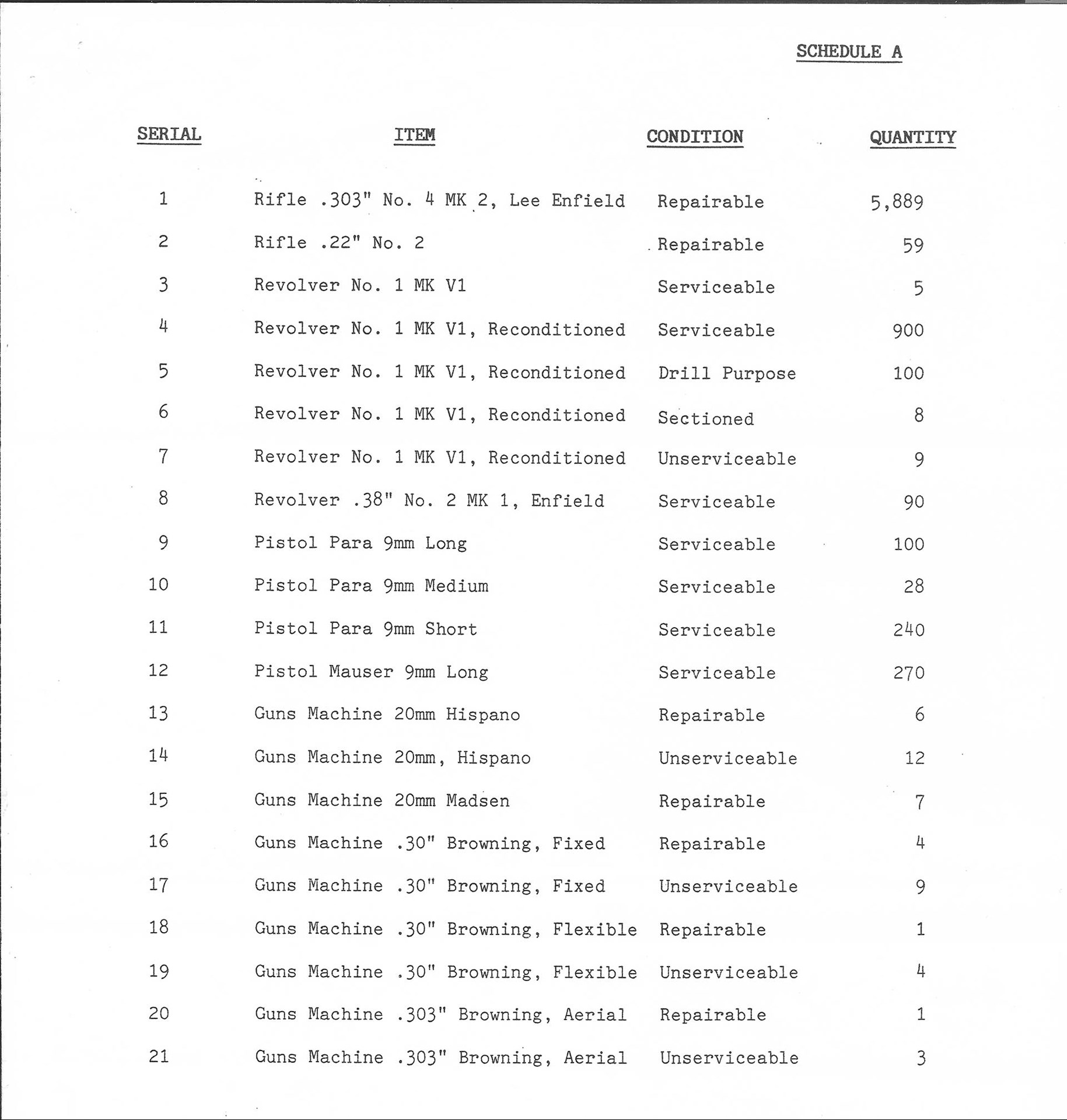 Although Edwards and his colleagues (one of whom, Charles Rausch, saved this listing) successfully bid on the small lot of Navy Lugers (28), someone else acquired the huge quantities of Army P1908 (240) and Artillery Lugers (100) shown here (apparently, about 35 Lugers of various types “went missing” between 1969 and 1990.) This purchaser has yet to be identified, but the value of these pistols certainly would be enhanced were the current owners of these pistols aware of their provenance. Photo courtesy of Vince Rausch.
Although Edwards and his colleagues (one of whom, Charles Rausch, saved this listing) successfully bid on the small lot of Navy Lugers (28), someone else acquired the huge quantities of Army P1908 (240) and Artillery Lugers (100) shown here (apparently, about 35 Lugers of various types “went missing” between 1969 and 1990.) This purchaser has yet to be identified, but the value of these pistols certainly would be enhanced were the current owners of these pistols aware of their provenance. Photo courtesy of Vince Rausch.
Although the provenance of the Irish Navy Lugers is known, the final disposition of the rest of the 340 or so Lugers from the 1990 auction is still unconfirmed. Perhaps the successful bidder sold them to collectors in the United States during the 1990s and they now reside in collections, with their owners having no idea about that particular gun’s history. From the number of Lugers in the auction, it would seem that at least some (if not many) of them were acquired, along with “Red Nine” C96 “Broomhandle” pistols, from Germany by the Irish Free State government in the early 1930s, as Dick Keogh surmised in his 1979 article. Luger collectors are invited to go over the serial number listings provided here, and check for import marks on their pistols to determine who brought the bulk of the Irish Lugers into the American collecting arena.
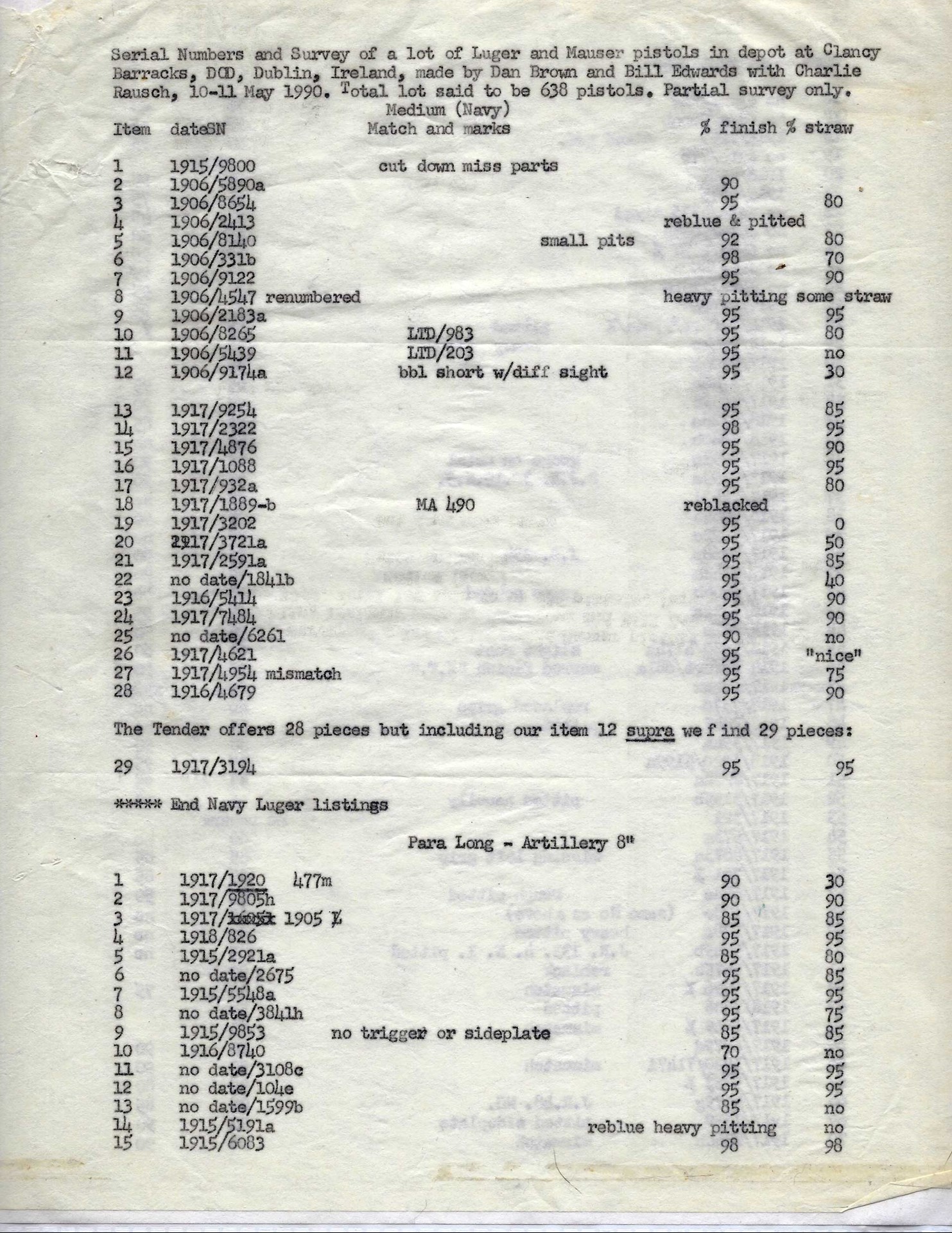 Before the 1990 auction commenced, the trio from Virginia viewed a sampling of the Lugers being offered in Dublin and typed notes about the pistols. This list begins with the Navy Lugers the trio acquired. Photo courtesy of Vince Rausch.
Before the 1990 auction commenced, the trio from Virginia viewed a sampling of the Lugers being offered in Dublin and typed notes about the pistols. This list begins with the Navy Lugers the trio acquired. Photo courtesy of Vince Rausch.
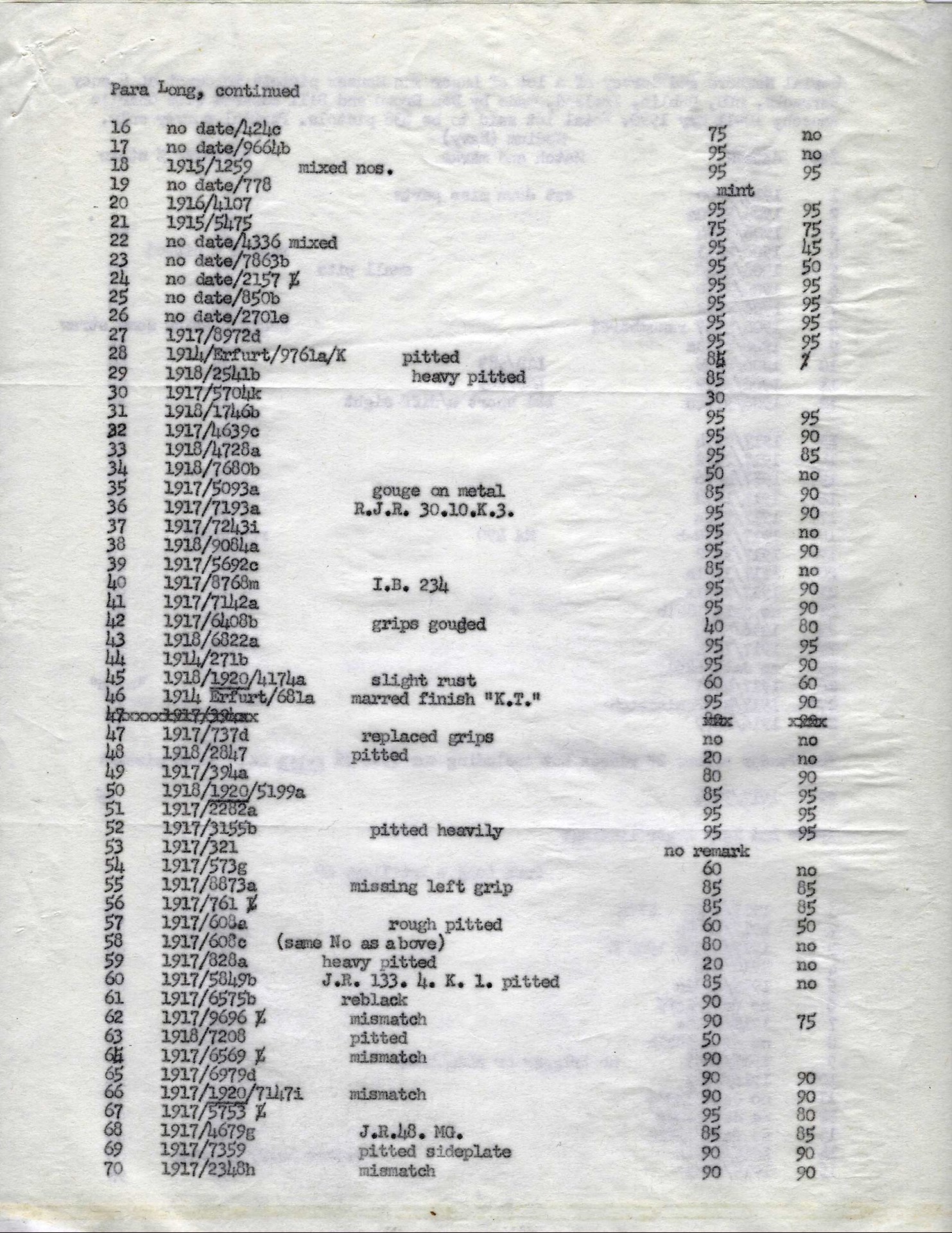 These notes offer a means for Luger collectors to identify pistols in their collections. Photo courtesy of Vince Rausch.
These notes offer a means for Luger collectors to identify pistols in their collections. Photo courtesy of Vince Rausch.
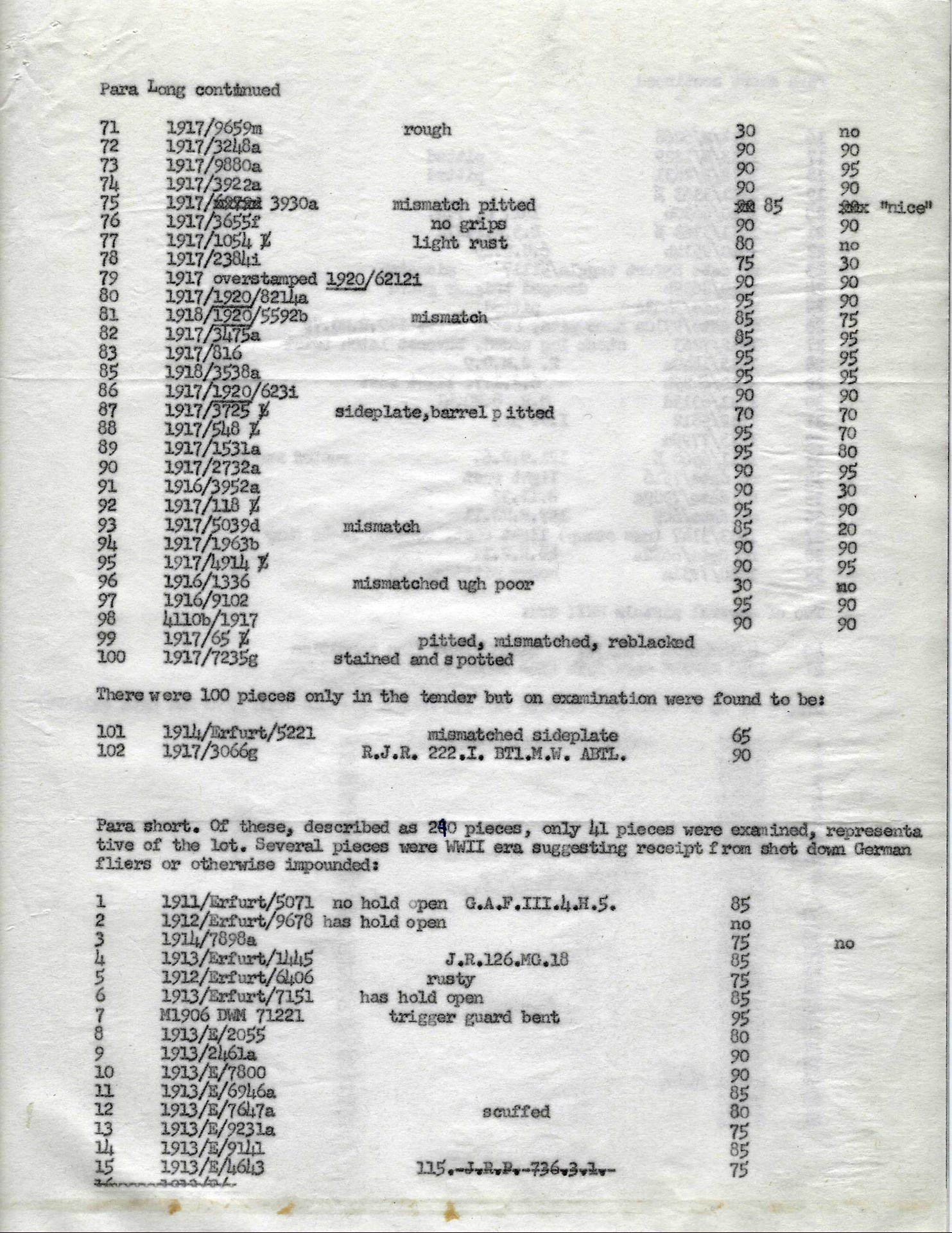 There are some surprises here, including World War II Lugers that most likely were taken from captured German aviators who crashed in the Republic of Ireland during the war. Photo courtesy of Vince Rausch.
There are some surprises here, including World War II Lugers that most likely were taken from captured German aviators who crashed in the Republic of Ireland during the war. Photo courtesy of Vince Rausch.
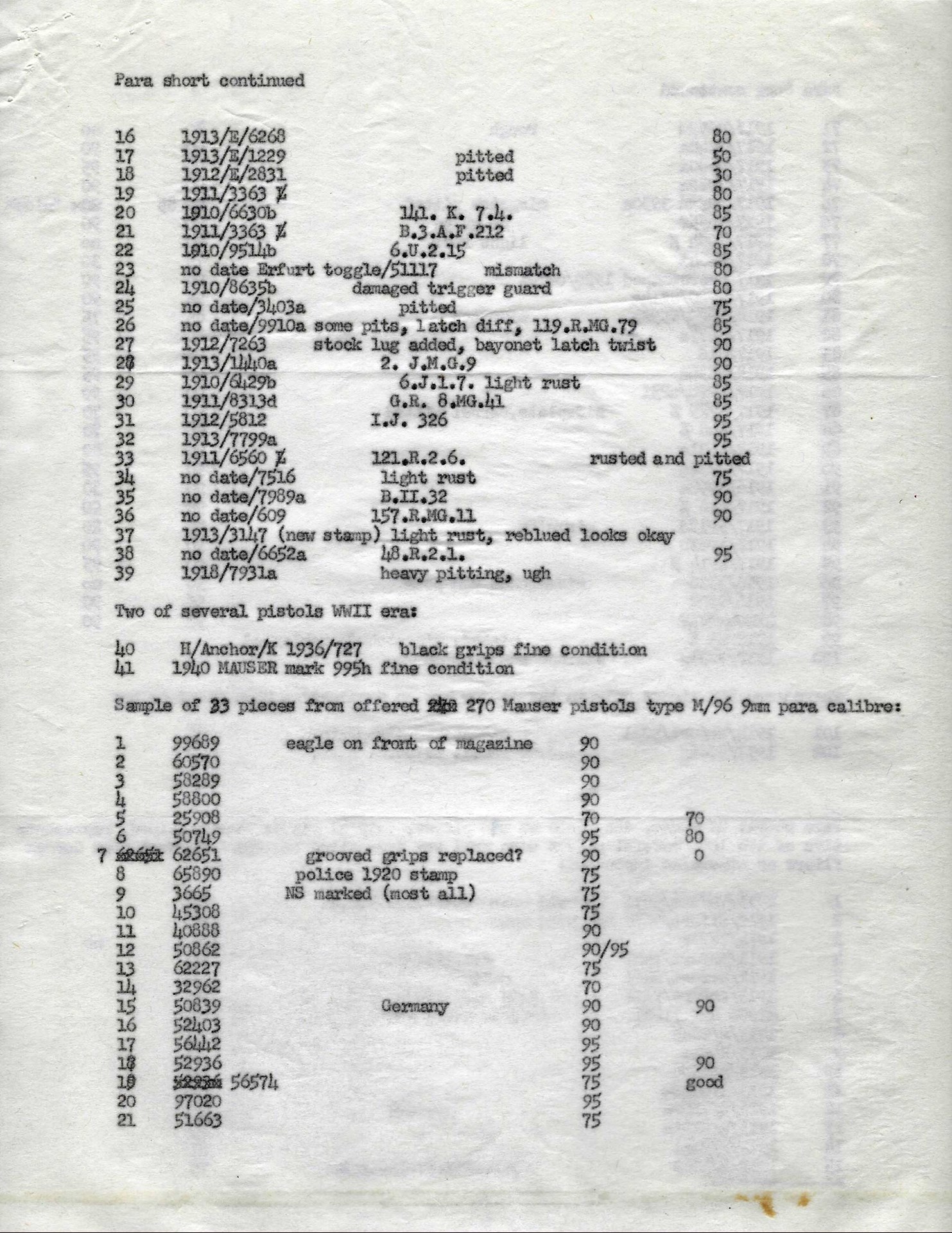 The story of the 270 Mauser pistols will be addressed in a forthcoming article on the American Rifleman Online website. Photo courtesy of Vince Rausch.
The story of the 270 Mauser pistols will be addressed in a forthcoming article on the American Rifleman Online website. Photo courtesy of Vince Rausch.
According to Irish museum curators, competition pistol shooters and living history interpreters, actual Irish Luger pistols are quite a rarity today in Ireland, whether deactivated or in firing condition. One bona fide IRA Artillery Luger is in the Pat O’Hagan private collection in Belfast, which is now on loan to a local museum, and a few more are scattered in collections across the country. Hopefully, the vast majority of the Irish Lugers, like the Irish “Howth Mausers” from the Easter Rising, hundreds of Irish Free State Lewis Light machine guns, hundreds of Webley and Smith & Wesson .455 revolvers, hundreds of “Broomhandle” Mausers, and thousands of SMLEs are now in the hands of American historical arms collectors, where they are preserved for future generations.
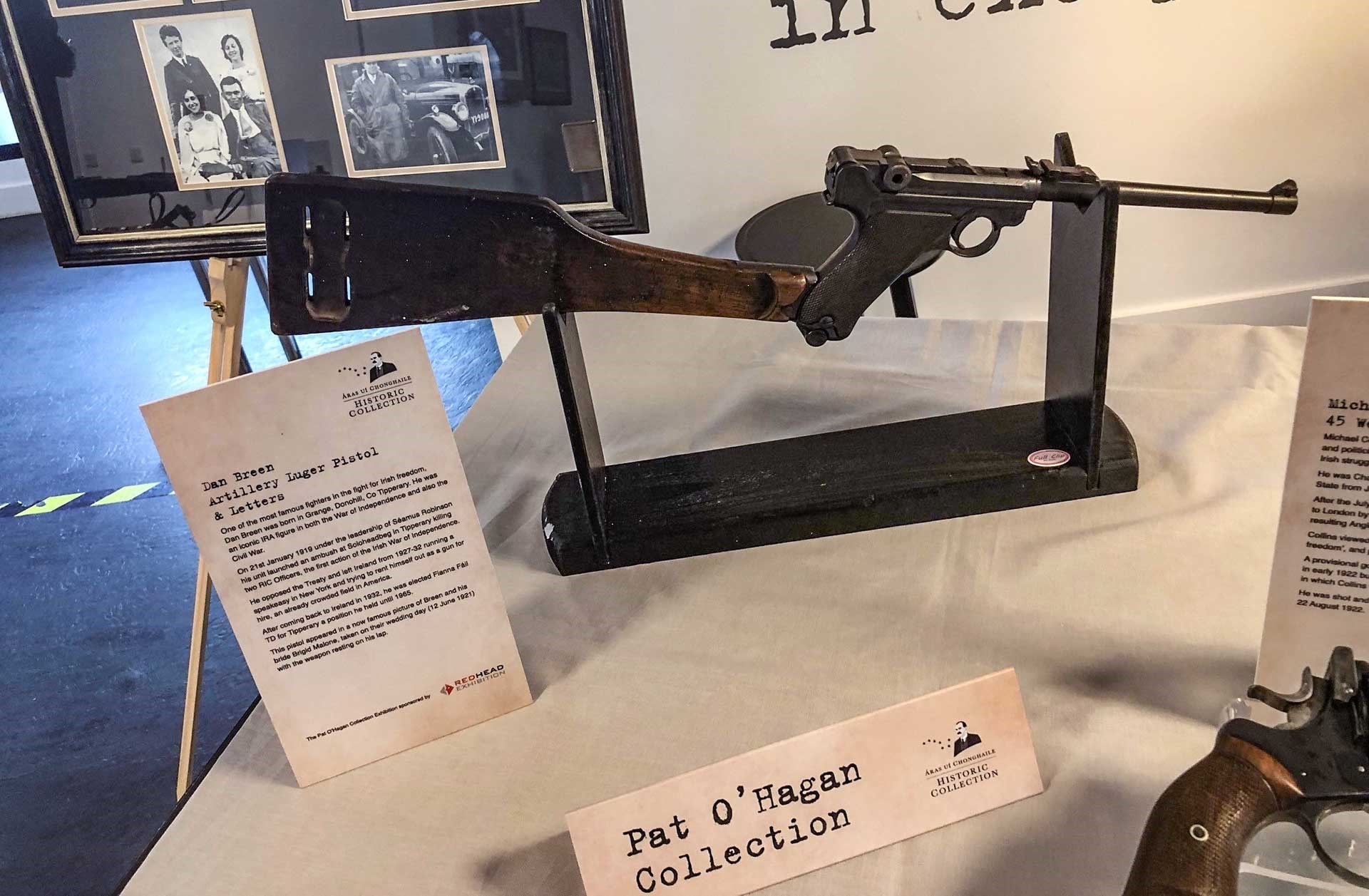 The subject of a recent award-winning documentary film entitled The Collector, Pat O’Hagan began collecting firearms from the 1913-1923 period of Irish history many years ago. Some of his extensive collection has been on exhibition at several venues in the past few years and is currently on loan to a museum in Belfast, Northern Ireland. Photo courtesy of Michael Curran.
The subject of a recent award-winning documentary film entitled The Collector, Pat O’Hagan began collecting firearms from the 1913-1923 period of Irish history many years ago. Some of his extensive collection has been on exhibition at several venues in the past few years and is currently on loan to a museum in Belfast, Northern Ireland. Photo courtesy of Michael Curran.
There is still much more to be learned about the role of the Luger in the struggle for Irish independence, and Luger collectors are urged to investigate the resources now at hand. After all, they are free and easy to use, and there are some cracking great stories in those accounts!
Ken Smith-Christmas is a frequent contributor to the American Rifleman magazine. He and Dick Keogh (a well-known firearms authority—especially on 9 mm handguns) have been good friends for more than 20 years through their mutual interest in Irish firearms. The authors thank Brenda Malone of the National Museum of Ireland, Vince Rausch and Michael Curran for their assistance with this article.


































